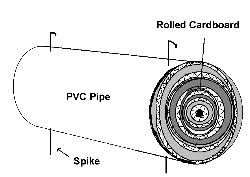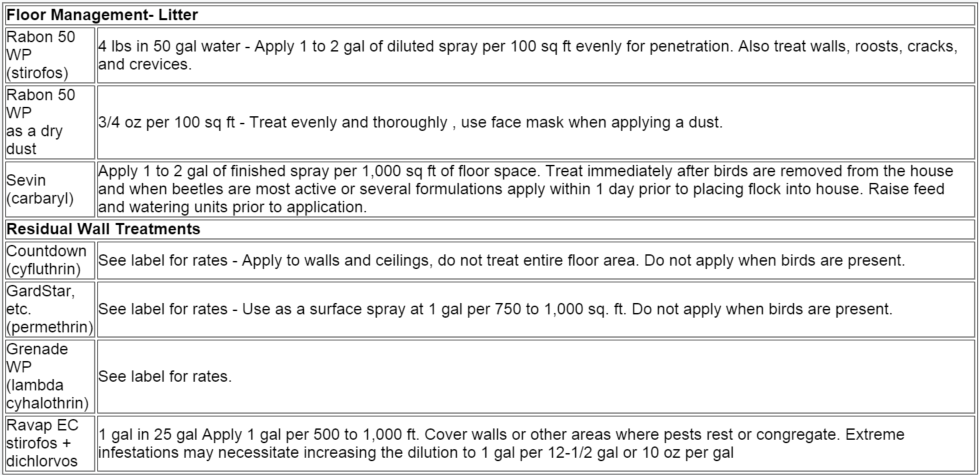Lesser Mealworms or Litter Beetles
ENTFACT-507: Lesser Mealworms or Litter Beetles | Download PDF
by Lee Townsend, Extension Entomologist
University of Kentucky College of Agriculture
Adult lesser mealworm adults are 1/2 inch long dark brown to black insects that also are sometimes called darkling beetles. The light yellow to brown larval stage has a hard, cylindrical body like that of a wireworm. When full grown, the larvae are 1/2 to 3/4 inch long. The adults and larvae can be found in floor litter where they feed on poultry feed, dried bird droppings, and bird carcasses. They are one of the best-adapted scavenger insects associated with both litter-based broiler operations and egg houses with deep-pit manure management systems.
Problems
Problems with this insect result from the gradual buildup of large numbers in broiler house litter. Food for these scavengers is plentiful so they only need some moisture from waterers or leaky pipes to thrive. Both adults and larvae are more active at night than during the day so large numbers may be present before the producer is aware of a problem.
- Structural damage occurs when the larvae leave the litter to find a dry spot in which to pupate and change to the adult stage. At this point, they may tunnel into polystyrene insulation materials or even wooden beams and supports. The larvae are more likely to leave the litter if they are very crowded. Extensive tunneling can ruin insulation and force expensive repairs.
- Invasions of homes or buildings by thousands of beetles has resulted in extreme actions to control the insects and even law-suits filed against producers by homeowners. Typically, this occurs when litter or manure from heavily-infested poultry houses has been spread over fields. If done when temperatures are warm, the beetles will fly from the field and may appear suddenly on and in homes. At night, beetles are attracted to lights ranging in intensity from a single candle to headlights of a car. They seem most likely to fly between 8 pm and midnight. There is no information on how far they can fly.
- Disease reservoirs are places where pathogens may remain and pose a threat to flock health. Lesser mealworms readily feed on dead and dying birds. They can become contaminated with pathogens such as Salmonella, Escherichia coli, or infectious bursal disease virus. Healthy birds can become infected after eating infected larval or adult litter beetles.
Biology and Behavior
Lesser mealworms usually are not distributed evenly throughout a house. They tend to congregate in areas that are most favorable for them. Usually, this is where there is adequate moisture or where the litter is looser and deeper. The larvae and adults tend to accumulate under anything laying on or just under the surface of the litter. Floor feeders provide excellent places for them to hide. If nothing is available, they will stay around the edges of caked litter. Mealworm larvae and adults avoid very dry or very wet areas but do need some moisture to survive.
Eggs are laid in batches in the litter and hatch in 4 to 5 days under typical room temperatures. The larval period, normally about 10 weeks, can be as short as 8 weeks. Following a 5 to 10 day pupal stage, the adult emerges. The average time from egg to adult takes about 80 days. The beetles can develop when the temperature is between 60°F and 90°F. The adults can live for several months.
Beetle Management
Effective litter management can slow the development of these beetles and reduce the chances of having excessive buildups of their numbers. Here are some practices to keep in mind.
- Water is a key need for mealworm beetles so check pipes and waterers for leaks. All measures to keep the litter dry will help to keep beetle numbers down.
- Feed storage areas or spilled feed outside the houses can be a starting point for infestations by beetles. Sanitation is very important.
- Move feeders and waterers when practical to pack down loose litter and make it less suitable for the insects.
- Regular clean out and disposal of litter can eliminate large numbers of beetles. It is best to do this when temperatures are low enough (near or below freezing) to kill most of the insects.
Sampling
The preference of mealworm larvae and beetles to get under objects has been used to develop a trap to monitor them in poultry litter. While there are no treatment guidelines in terms of numbers of beetles caught, you can detect them early and look at changes in trap counts over time. The trap catches also let you evaluate control measures that have been applied. At least a few beetles will be found in most houses, there is no way to eradicate or exclude them.
 Mealworm Trap
Mealworm Trap
The trap is a 9-inch length of 1-1/2 inch PVC pipe that contains a piece of 8-inch x 11-inch corrugated cardboard that has been rolled up so that the 8-inch length is inside the pipe. Lesser mealworm beetles and larvae will crawl between the cardboard layers to hide. Holes should be drilled at each end of the pipe so that stakes can be used to hold the trap in place in the litter. The traps should be put in open centers of the house for easy retrieval. Avoid placing them near walls, feeders, or waterers. The litter is usually more tightly packed there; the beetles and larvae prefer looser litter.
Three traps, approximately evenly spaced along the center line of each house, should be adequate for routine monitoring. They can be checked easily by removing and unrolling the cardboard to count beetles and larvae. The date and numbers found should be recorded so that and trends in can be detected. If necessary, the rolled cardboard from each trap can be placed in individual plastic bags and examined later. In this case, just put a new piece of cardboard in the PVC pipe and put the trap back in the same general area.
The traps need to be checked at regular intervals for the numbers to be meaningful. Once a week or once every two weeks should be adequate. Be sure to record the numbers in a consistent way. For example, as an average number of beetles per week for each house. While numbers of beetles in the trap cannot be related to numbers per square foot in the house, changes in trap counts over time are what is important.
Insecticides
It is virtually impossible to eliminate these insects from a house with insecticides. They are protected down in the litter and the litter itself may bind the products and reduce their effectiveness. Read the label carefully for complete instructions. Some products may be used in floor litter while others are only for residual sprays on walls.

Issued: 2/98
Revised: 2/98
CAUTION! Pesticide recommendations in this publication are registered for use in Kentucky, USA ONLY! The use of some products may not be legal in your state or country. Please check with your local county agent or regulatory official before using any pesticide mentioned in this publication.
Of course, ALWAYS READ AND FOLLOW LABEL DIRECTIONS FOR SAFE USE OF ANY PESTICIDE!
Images: University of Kentucky Entomology
